Like all things, your eCommerce marketing strategy cannot possibly become “good” all on its own.
Having a clear marketing strategy is essential for the success of your online business.
Online business strategies are a bit different than your more-traditional marketing strategies.
That is to say, you have to not only fight to get your voice heard in a crowded marketplace 24/7.
BUT…
You also have to convince those people you do get in front of, of purchasing your products.
Becoming customers.
Granted, this is a semi-basic understanding of all business strategy frameworks.
So, from the top….
WHAT IS AN eCOMMERCE MARKETING STRATEGY?
A strategy is a comprehensive plan of action for promoting and selling products or services online.
It involves the use of various tactics and channels to attract and engage potential customers, build brand awareness, and drive sales and revenue.
An effective eCommerce marketing strategy takes into account these six (6) factors:
- Business Goals
- Buyer Personas
- Target audience
- eCommerce platforms
- Content strategy
- Pricing strategy
It also involves ongoing analysis and optimization to ensure the strategy is aligned with market trends and customer preferences, and is generating the desired results.
Advertising is just one aspect of marketing.
Albeit, an important one!
Likewise, part of your eCommerce marketing strategy.
Think of advertising as, ‘amplification’ of your marketing, more than anything else.
If your marketing is bad, you’ll know it because you’ll be burning piles of cash.
If it’s good, you’ll know that too, as you’ll be making revenue hand over fist!
What is the difference between eCommerce marketing and digital marketing?
Within eCommerce we have to go beyond just advertising the brand….
You also have to promote your products.
Primarily through using search ads, social ads, video ads, and display ads.
This is where digital marketing comes into play.
Think of the square and rectangle bit.
A rectangle can be a square, but a square cannot be a rectangle.
Similar with eCommerce AND digital marketing.
eComm marketing is a small aspect of the bigger digital marketing scheme.
The abundance of marketing channels makes this a lot more fun than it did, even just 3-4 years ago.
In part, the success of your eCommerce Marketing Strategy, really depends on your ability to highlight your offerings across multiple channels, in multiple forms, and multiple ways.
Why You Need a Clear Strategy
We all agree that your brand needs to gain trust, to attract new customers.
You will need to:
- Build trust with consumers.
- Increase organic traffic.
- Engage and convert more page visitors on your site.
- Retain customers and get them to spend more with you.
- Decrease operational costs.

To Build Consumer Trust online is difficult.
Incorporating it into your strategy is a must.
As each day passes, you need to increase your standing among competitors.
More importantly, you need to outperform them.
This is why it’s absolutely essential to develop an eCommerce marketing strategy that converts and retains customers.
Shows them solutions to their problems.
And will help build their trust in you…
So they know you’re the one they can count on.
Benefits of Having a Clear Strategy
Since you are here, it shouldn’t necessarily need to be spelled out.
As you’re most likely already aware of the benefits.
But… just in case…
Having a plan in-place, and tightly locked in strategy, offers numerous benefits for your brand.
As well as your sanity.
Here are some of the key advantages you can gain from having a well-planned and executed strategy:
INCREASED SALES AND REVENUE
With a clear strategy in place, you can focus your efforts on the tactics and channels that are most likely to generate sales and revenue.
By understanding your target audience and buyer personas…
You can create personalized and targeted campaigns that resonate with your potential customers.
And ultimately drive conversions.
IMPROVED CUSTOMER ENGAGEMENT AND LOYALTY
An effective eCommerce marketing strategy can help you build strong relationships.
Your customers are looking for relevant information, similar to why you are here today.
And they love being engaged by content they find engaging and informative…
Providing exceptional customer service.
AND, offering personalized experiences,
You’re cultivating customer loyalty and repeat business.
ENHANCED BRAND AWARENESS AND REPUTATION
Recognition and consistency is a must with your content & your brand across every marketing channel.
You can increase brand awareness and establish a strong reputation in your industry through a clear strategy.
This will help you stand out from your competitors and attract new customers.
COMPETITIVE ADVANTAGE IN THE MARKET
With the growing number of eCommerce businesses in the market, cutting through the noise can be excruciating.
When you’re up-to-date with the latest trends and technologies in the industry, you can stay ahead of the curve.
As well as, position your business for future success.
It is what will drive the success of your brand.
It provides a roadmap for achieving your business goals and enables you to focus your efforts and resources on the most effective tactics and channels.
In summary:
- By understanding your target audience and buyer personas.
- Choosing the right eCommerce platforms.
- Creating a compelling eCommerce content strategy.
- Developing effective campaign ideas Implementing a pricing strategy.
- Establishing a clear business strategy framework. And;
- Studying other eCommerce marketing strategy examples.
You’ll create a strategy that is tailored directly to your needs and goals.
Key Elements of an Effective Strategy
Understanding, not only who your target audience is, but also what motivates them is critical.
By creating detailed buyer personas to refer to…
You can tailor your marketing efforts to the needs and preferences of your ideal customers.
Understanding Your Target Audience and Buyer Personas
To create detailed buyer personas, you need to:
- Conduct research & gather data on your customers’ Demographics, Psychographics, Behavior, and Preferences.
This topic is bullet pointed to show its importance, and have articles that go into way more depth regarding this subject.
But essentially…
This can be done through surveys, interviews, social listening, analytics tools, and customer feedback.
You can also use segmentation to group your customers into smaller, more specific categories.
AND, tailor your marketing messages to each segment (group).
CHOOSING THE RIGHT eCOMMERCE PLATFORM
Selecting the right eCommerce platform is essential for creating a seamless and user-friendly online shopping experience for your customers.
When choosing a platform, you should consider not only the technical features and functionality, but also the user experience, security, scalability, customization, and integration options.
You’ll want to consider factors such as:
- Ease of use
- Payment processing options
- Compatibility with third-party integrations
You may also want to test different platforms and compare their performance and cost-effectiveness.
As far as platforms go, Shopify is your obvious number #1.
Others would be:
- Magento (Adobe)
- Woocommerce
- BigCommerce
- Wix
Through personal experience, Shopify is the primary platform everyone uses. Rarely see Magento, but never see the others.
We also tend to see custom built sites…
My answer to that is SMH.
Way too complicated, will cost more in the long run, and doesn’t integrate with anything.
With the technology of today, Shopify should do everything, and more.
CREATING A COMPELLING eCOMMERCE CONTENT STRATEGY
High-quality, engaging content is one of the most important elements of your strategy.
Some low-hanging fruit content ideas include:
- Product descriptions
- Blog posts
- Social media content
- Email newsletters
By providing value to your potential customers…
And offering relevant solutions.
You’ll attract more customers and retain them for longer.
Increase your brand’s overall awareness.
AND, ultimately, increase conversions.
In addition to the low-hanging fruit content ideas mentioned…
You can also explore other types of content that can enhance your brand’s authority.
Like, thought leadership, and storytelling.
These can include videos, infographics, white-papers, case studies, webinars, podcasts, and user-generated content (UGC).
You should also align your content with your brand voice, values, and messaging.
DEVELOPING EFFECTIVE CAMPAIGN IDEAS
Creating campaigns that are effective (keyword here), are essential for your eCommerce Marketing Strategy.
Consider using a mix of paid and organic channels, like:
- Paid Social Ads
- Paid Search
- Influencer Marketing
- Email Marketing
- and SEO
In order to reach your target audience and achieve your marketing goals.
The process for developing these types of campaigns is very fundamental…
You should first define your campaign goals, success metrics, and budget.
Then, you can brainstorm creative ideas.
Make sure they resonate with your audience AND align with your brand identity.
ALSO
Test different variations of your campaigns.
Use A/B split testing or multivariate testing.
Be sure to track everything and measure your performance.
Not every campaign is a winner and that’s okay.
What’s that old saying, “The Master has failed more times than the beginner has tried.“
In other words, you won’t know the results unless you take the risk of testing.
IMPLEMENTING A PRICING STRATEGY
Setting the right prices for your products is a critical aspect of any strategy.
Factors like production costs, competitor pricing, and consumer demand…
Will all determine your pricing strategy.
After considering those factors, you’ll want to diving into these topics:
- Business objectives (i.e., Goals)
- Costs
- Value proposition
- And competition
Dynamic, bundle, tiered, or subscription are all pricing models dependent on your product.
Your model also will determine your strategy.
Also be sure to communicate your pricing clearly and transparently…
This will help to avoid confusing or misleading your customers.
Getting Technical With Your eCommerce Strategy
There are few marketing tactics available that are unique to online stores.
e.g., you can take advantage of post-purchase follow-up.
The framework you’ve designed once someone purchases something from your store.
They’ve trusted you enough to give you their hard earned money.
Now, you just have to follow-up.
Find a way to keep the conversation going.
Easier said than done, I know…
BUT
You can do this by sending follow-up emails and adding them to your post-purchase series.
You can also use this tactic to gauge a customer’s interest in your other products.
More importantly, however…
Staying in contact with your buyers shows that you care about their shopping experience.
ESTABLISHING A CLEAR BUSINESS STRATEGY FRAMEWORK
Having a clear framework that aligns with your eCommerce marketing strategy is essential for achieving success.
Again… (for like the 14th time)
Consider factors such as your target market, competitive advantage, and revenue goals when developing your business strategy framework.
Remember to continuously monitor and analyze your strategies performance.
And make adjustments as needed to stay ahead of the game.
The number one thing I can tell you absolutely is, the game always changes.
The only constant is change (remember this from middle school science class?).
Lastly, the biggest piece of the puzzle that will help you with devising your strategy are…
Drum roll please
Your brand values.
Not as dramatic as you thought huh!?!
Your brand values will frame, or dictate, your strategy’s framework.
Kind of like boundaries.
Or a roadmap, per-se.
Letting you know what you should and shouldn’t do, in relation to your strategy.
Best Practices for Executing Your Strategy
Implementing an eCommerce marketing strategy can be a complex and challenging process.
However…
By following the best practices, you can increase your chances of success.
Here are some of the best practices we’ve found that work…
eCommerce Marketing Example Best Practices:
- Start with a clear understanding of your business goals and objectives.
Your eCommerce marketing strategy should align with your overall business strategy. This will start you off on the right path and really, help achieve your overarching objectives. - Invest in high-quality content creation.
Creating fun and informative content can help you attract and retain customers. As well as, improve your search performance and your overall market penetration. - Leverage social media platforms to promote your products and connect with your audience.
By regularly posting on social media and engaging with your followers, you’ll build strong relationships and fans. Social has also become the top-spot for customer service oriented operations, where most customers would rather DM you than email you. Also known as Community Management. - Utilize data analytics to monitor and optimize your marketing efforts.
By tracking key metrics such as traffic, conversion rates, and engagement, you can identify areas for improvement. And make better, data-driven, decisions. - Stay up-to-date with the latest trends and technologies in the eCommerce industry.
By attending industry events, reading industry publications, and engaging with other eCommerce professionals, you can stay ahead of the curve and position your business for success. - Collaborate with influencers and other businesses to expand your reach and drive sales.
By partnering with relevant influencers and businesses, you can tap into their audiences and increase your brand exposure.
If you’re able to implement these, you’ll create a comprehensive strategy that delivers results.
Period.
Full Stop.
Just remember to regularly evaluate and optimize, to stay ahead of your competitors.
And of course, achieve long-term success from your strategies.
Common Mistakes to Avoid When Implementing Your Strategy
These will negatively impact your success.
Here are some mistakes to avoid:
- Neglecting platforms where your audience is located.
Your eCommerce platform is the foundation of your online business, and neglecting it can lead to poor user experience and lost sales. Make sure to regularly update and optimize your platform to ensure it meets your customers’ needs.Sometimes you may have to eat the cost and switch to entirely new platform. - Focusing too heavily on advertising.
While advertising can be an effective marketing tactic, it shouldn’t be the sole focus of your eCommerce marketing strategy. Consider other tactics such as content marketing, social media marketing, and email marketing to diversify your approach. Remember, advertising is just amplification, so if it’s not working, you’ll want to find the real problems first. - Ignoring data analytics.
Feedback systems are a must for any business, let alone its strategies. Without regular monitoring and analysis of your marketing efforts, it can be challenging to identify problem areas. You need to regularly track key success metrics in order to make better decisions. - Failing to stay ‘in the know’, when it comes to industry trends and changes.
The eCommerce industry is constantly evolving. And failing to stay current can put your business at a disadvantage. Make sure to stay informed about the latest trends, tech, and best practices.
By avoiding these common mistakes, and following the previous best practices, you’ll be right where you need to be.
…In the driver’s seat ready to execute on your strategy.
And that is where your bottom-line lives.
Driving sales and revenue is always at the root of every marketing strategy.
Remember to regularly evaluate and adjust to stay ahead of your competitors and achieve consistent, sustainable, growth.
Next Steps In Executing Your NEW Marketing Strategy
As you embark on creating and implementing your eCommerce marketing strategy, remember that it’s not a one-and-done process.
It’s a continuous cycle of planning, execution, evaluation, and optimization.
The eCommerce industry is constantly evolving, and what works today may not work tomorrow.
What is the ‘Best eCommerce Marketing Strategy’?
Of course you want to know if there is some sort of, “Secret Sauce“…
Welp, there are lessons in life one learns.
And let me be the first to tell you, in case no one has.
Most great and amazing things come to those who grind.
Hard work (yeah, I know, I don’t like it either), but…
It’s almost a guarantee that if you do, you’ll win in the end.
By staying informed, being adaptable, and putting your customers first, you can create a strategy that drives long-term success for your brand.
So, take the time to understand your audience.
Choose the right platforms.
Create compelling content.
And you’ll be geared up for developing effective campaigns, implementing the right pricing strategy, and establishing a clear road to success.
Beyond understanding what the benefits of a clear strategy are…
My hope is you’ve got enough information to at least start…
Start to drive sales, engage your customers, and build a strong brand reputation.



1 thought on “The Importance of Having a Clear eCommerce Marketing Strategy”